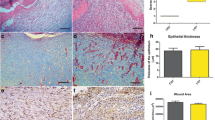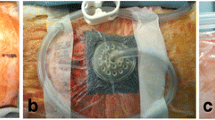Background and Purpose:
Despite the enormous therapeutic potential of modern radiotherapy, common side effects such as radiation-induced wound healing disorders remain a well-known clinical phenomenon. Topical negative pressure therapy (TNP) is a novel tool to alleviate intraoperative, percutaneous irradiation or brachytherapy. Since TNP has been shown to positively influence the perfusion of chronic, poorly vascularized wounds, the authors applied this therapeutic method to irradiated wounds and investigated the effect on tissue oxygenation in irradiated tissue in five patients.
Material and Methods:
With informed patients' consent, samples prior to and 4 and 8 days after continuous TNP with -125 mmHg were obtained during routine wound debridements. Granulation tissue was stained with hematoxylin-eosin, and additionally with CD31, HIF-1α (hypoxia-inducible factor-1α), and D2-40 to detect blood vessels, measure indirect signs of hypoxia, and lymph vessel distribution within the pre- and post-TNP samples.
Results:
In this first series of experiments, a positive influence of TNP onto tissue oxygenation in radiation-induced wounds could be demonstrated. TNP led to a significant decrease of 53% HIF-1α-positive cell nuclei. At the same time, a slight reduction of CD31-stained capillaries was seen in comparison to samples before TNP. Immunostaining with D2-40 revealed an increased number of lymphatic vessels with distended lumina and an alteration of the parallel orientation within the post-TNP samples.
Conclusion:
This study is, to the authors' knowledge, the first report on a novel previously not described histological marker to demonstrate the effects of TNP on HIF-1α expression as an indirect marker of tissue oxygenation in irradiated wounds, as demonstrated by a reduction of HIF-1α concentration after TNP. Since this observation may be of significant value to develop possible new strategies to treat radiation-induced tissue injury, further investigations of HIF-1α regulation under TNP are warranted.
Hintergrund und Ziel:
Trotz des enormen therapeutischen Potentials der modernen Strahlentherapie stellen chronische Wundheilungsstörungen weiterhin ein bekanntes klinisches Phänomen dar. Die topische Unterdruckbehandlung (TNP [„topical negative pressure therapy“]) ist ein neues Verfahren, welches die intraoperative oder perkutane Radiatio ebenso wie die Brachytherapie erleichtert. Da TNP in chronischen, schlecht vaskularisierten Wunden die Gewebeperfusion positiv beeinflusst, wendeten die Autoren diese neuartige Therapieoption bei Strahlenulzera an und untersuchten den Einfluss der TNP auf die Gewebeoxygenierung in strahlengeschädigtem Gewebe.
Material und Methodik:
Mit Einverständnis der Patienten wurden jeweils Proben vor und nach 4 bzw. 8 Tagen kontinuierlicher TNP (Sogstärke -125 mmHg) bei allfälligen chirurgischen Débridements gewonnen. Neben einer Hämatoxylin-Eosin-Färbung zur Identifizierung von Granulationsgewebe erfolgte eine Färbung mit dem Endothelzellmarker CD31. Mittels D2-40 wurden die Lymphgefäßverteilung ermittelt und die Veränderung der Gewebeoxygenierung mit dem Hypoxiemarker HIF-1α („hypoxia-inducible factor-1α“) untersucht.
Ergebnisse:
In dieser ersten Reihe von Experimenten konnte ein positiver Einfluss der Vakuumtherapie auf die Gewebeoxygenierung in strahlengeschädigtem Gewebe gezeigt werden. Unter TNP kam es zu einer deutlichen Reduktion (53%) HIF-1α-angefärbter Zellkerne. Gleichzeitig war auch eine leicht verminderte Anzahl an Kapillaren im Vergleich zu den Proben vor TNP zu beobachten. Die immunhistochemische Färbung mit D2-40 erbrachte hingegen eine erhöhte Dichte an Lymphgefäßen mit vergrößerten parallel ausgerichteten Lumina.
Schlussfolgerung:
In dieser Studie konnte mit Hilfe eines hierfür bisher nicht beschriebenen Markers erstmals der Einfluss einer TNP von bestrahltem Gewebe auf die Gewebeoxygenierung anhand des HIF-1α gezeigt werden. Diese Befunde könnten für die Entwicklung neuer Therapieoptionen bei strahleninduzierter Gewebeschädigung von Bedeutung sein und als Grundlage für weitere Studien dienen.
Similar content being viewed by others
Author information
Authors and Affiliations
Corresponding author
Additional information
*Both authors contributed equally to the study.
Rights and permissions
About this article
Cite this article
Grimm*, A., Dimmler*, A., Stange, S. et al. Expression of HIF-1α in Irradiated Tissue is Altered by Topical Negative-Pressure Therapy. Strahlenther Onkol 183, 144–149 (2007). https://doi.org/10.1007/s00066-007-1560-1
Received:
Revised:
Issue Date:
DOI: https://doi.org/10.1007/s00066-007-1560-1




